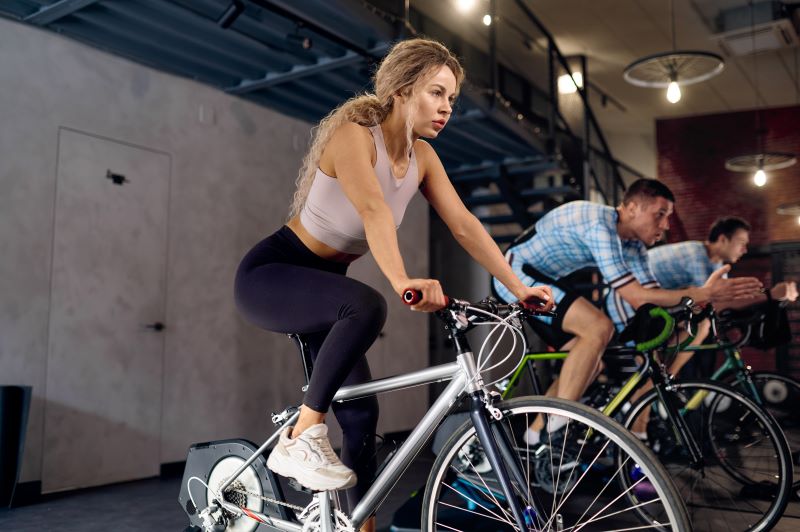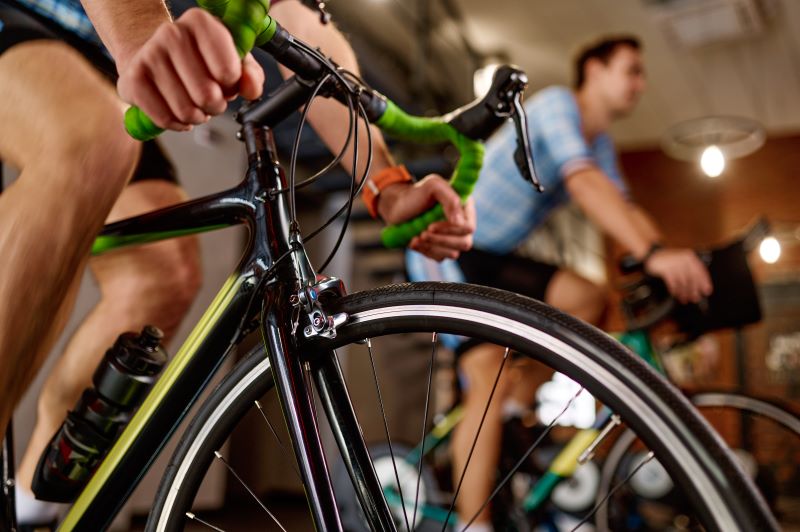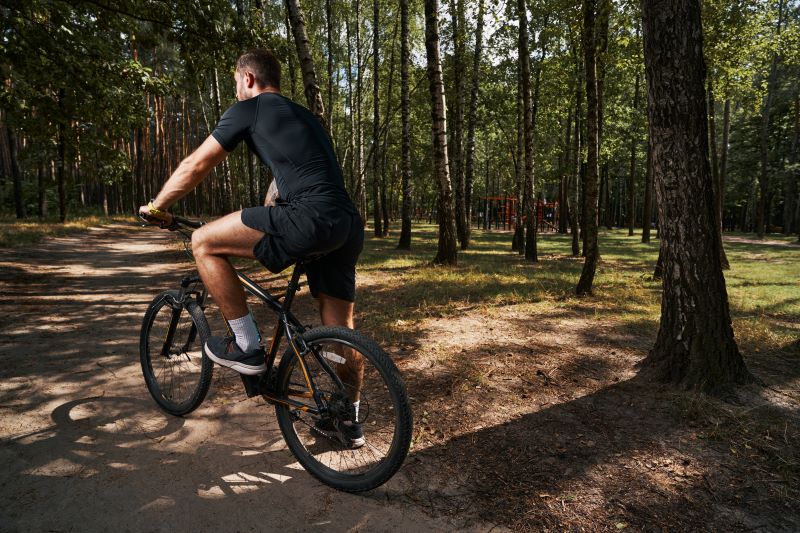Get ready to hit the road and feel the wind in your hair as you embark on a cycling journey like no other. Pedal Power: The Essential Manual for Cycling Training is here to take your riding skills to new heights, providing you with all the knowledge, techniques, and motivation you need to become a true cycling powerhouse.
Like a symphony of gears and pedals, this manual will guide you through the intricacies of building strength and endurance, perfecting your technique, and tailoring your training to reach your cycling goals.
Imagine yourself gliding effortlessly down a winding mountain road, each pedal stroke propelling you forward with power and grace. With Pedal Power by your side, this dream can become reality.
Through expert advice from seasoned cyclists and trainers, you’ll learn how to build strength in both body and mind so that every ride becomes an opportunity for growth. Discover the secrets behind increasing your endurance levels, pushing past limits you never thought possible.
Whether you’re a beginner cyclist looking to improve or an experienced ride-fit seeking new challenges, this manual has something for everyone.
So grab hold of those handlebars tight – it’s time to unleash the full potential of your pedal power!
Key Takeaways
- Bike fit and positioning are crucial for comfort, control, and injury prevention.
- Strength training exercises can significantly enhance cycling performance.
- Proper nutrition, hydration, and electrolyte replenishment are essential for optimal performance.
- Tailoring training to goals and incorporating interval workouts can improve speed, endurance, and overall performance.
Building Strength and Endurance
Building strength and endurance is crucial for cyclists, as it allows you to ride longer distances and tackle challenging terrains with ease. Did you know that a study found that regular strength training can increase your power output by up to 10%?
By incorporating specific exercises into your training routine, such as squats, lunges, and deadlifts, you can target the muscles used in cycling and improve your overall performance on the bike.

In addition to strength training, nutrition strategies also play a vital role in enhancing speed and endurance. Fueling your body with the right nutrients before, during, and after rides can help optimize your energy levels and prevent fatigue.
It’s important to consume a balanced diet that includes carbohydrates for quick energy release, protein for muscle repair and growth, and healthy fats for sustained energy. Proper hydration is also key in maintaining optimal performance on the bike. Make sure to drink enough water throughout the day and consider using electrolyte-rich drinks or supplements during longer rides to replenish any lost minerals.
By prioritizing building strength and endurance through targeted exercises and proper nutrition strategies, you’ll be able to improve your speed on the bike while also preventing fatigue. Remember that consistency is key when it comes to training – make sure to incorporate these elements into your routine regularly to see significant improvements in your cycling performance. Keep pushing yourself, stay motivated, and enjoy the benefits of a stronger body on two wheels!
Perfecting Your Technique
To improve your cycling technique, it’s crucial to focus on proper bike fit and positioning. Ensuring that your bike is adjusted correctly for your body can help prevent discomfort and injury while maximizing power transfer.
Additionally, mastering cornering and descending techniques will enhance your overall riding skills. This will allow you to navigate turns with confidence and descend steep hills safely.
By paying attention to these key points, you’ll be well on your way to becoming a more efficient and skilled cyclist.
Proper Bike Fit and Positioning
Ensuring a proper bike fit and positioning is crucial for optimizing your cycling performance. When it comes to bike fit optimization, there are several key factors to consider.
First and foremost, make sure that your saddle height is adjusted correctly. This will help you avoid putting unnecessary strain on your knees and ensure that you’re able to generate maximum power with each pedal stroke.
In addition to saddle height, it’s important to pay attention to your handlebar position. The handlebars should be positioned at a comfortable height and distance from the saddle, allowing you to maintain a relaxed and efficient riding posture. This will not only improve your overall comfort but also enhance your control over the bike.
Proper bike fit goes beyond just comfort and control; it also plays a crucial role in injury prevention strategies. A poorly fitted bike can lead to various issues such as knee pain, lower back pain, or even numbness in the hands or feet. By taking the time to adjust your bike fit according to your body measurements and preferences, you can significantly reduce the risk of these injuries.
Investing in a professional bike fitting service is often recommended for serious cyclists who want to optimize their performance and prevent injuries. A professional fitter will take into account factors such as leg length discrepancy, flexibility levels, and riding style when making adjustments to your bike fit. Remember, a properly fitted bike not only enhances your cycling experience but also allows you to push yourself further without compromising your safety or comfort.
Cornering and Descending Techniques
As you carve through the curves and descend down the road, mastering cornering and descending techniques will transport you into a thrilling dance with gravity. These skills are essential for any cyclist looking to improve their overall performance and ride with confidence.
Here are four key techniques to help you navigate corners and descents like a pro:
- Body Positioning: When approaching a corner, shift your weight towards the inside of the turn by leaning your bike while keeping your upper body upright. This allows for better traction on the tires and helps maintain balance throughout the curve.
- Braking Technique: Before entering a corner, gradually apply both brakes evenly to control your speed. Avoid sudden or excessive braking, which can cause loss of traction and lead to skidding or sliding.
- Line Selection: Choose an appropriate line through the corner by starting wide, then gradually cutting in towards the apex (the innermost point of the turn). This allows for a smoother arc and minimizes any potential contact with obstacles or other riders.
- Descending Confidence: When descending, maintain an aerodynamic position by tucking in close to your bike and lowering your center of gravity. Relax your grip on the handlebars but keep them firmly controlled for stability.
By implementing these cornering techniques and descending strategies, you’ll not only enhance your performance but also feel more confident as you take on challenging roads and conquer exhilarating descents. So go ahead, embrace gravity’s pull, and experience cycling at its most thrilling level!
Tailoring Your Training to Your Goals
To tailor your training to your goals, start by creating a training plan that outlines the specific workouts and milestones you want to achieve. This will help you stay organized and focused on what you need to do to reach your objectives.
Additionally, incorporating interval workouts into your training routine can be highly effective in improving your speed, endurance, and overall performance on the bike. By pushing yourself during short bursts of intense effort followed by periods of active recovery, you can maximize the efficiency of your training and make significant progress towards reaching your cycling goals.
So, get started on creating a personalized training plan and don’t forget to include those challenging interval workouts for optimal results!
Creating a Training Plan
Crafting a training plan is crucial for maximizing your cycling performance. It not only helps you stay organized and focused, but it also ensures that you’re working towards your specific goals.
When creating your training plan, consider incorporating the following nutrition tips to fuel your rides:
- Hydrate properly: Drink plenty of water before, during, and after your workouts to stay hydrated and maintain optimal performance.
- Eat a balanced diet: Include a variety of fruits, vegetables, lean proteins, whole grains, and healthy fats in your meals to provide your body with the necessary nutrients for cycling.
- Time your meals strategically: Eat a carbohydrate-rich meal or snack before longer rides to provide sustained energy. Additionally, refuel within 30 minutes after intense workouts with a combination of carbohydrates and protein to aid in muscle recovery.
- Consider supplements: Consult with a sports nutritionist or healthcare professional about incorporating supplements such as electrolytes or protein powder into your routine if needed.
In addition to proper nutrition, incorporating recovery strategies into your training plan is essential for preventing injuries and optimizing performance. Here are some key strategies to consider:
- Prioritize rest days: Allow yourself regular rest days throughout the week to give your body time to repair and recover from intense workouts.
- Incorporate active recovery exercises: Engage in low-intensity activities such as light stretching or easy spinning on rest days to promote blood flow and reduce muscle soreness.
- Get enough sleep: Aim for 7-9 hours of quality sleep per night as it plays a vital role in muscle repair and overall recovery.
- Utilize foam rolling or massage therapy: These techniques can help release tension in muscles and improve flexibility.
By crafting a well-rounded training plan that includes these nutrition tips and recovery strategies, you’ll be well on your way to improving your cycling performance while maintaining optimal health. Remember that consistency is key – stick to your plan and enjoy the journey towards achieving your goals.
Incorporating Interval Workouts
Maximize your performance by incorporating interval workouts into your training plan, pushing yourself to new limits and achieving faster results.
High-intensity interval training (HIIT) workouts are a powerful tool for improving your cycling performance. These workouts involve alternating between periods of intense effort and recovery, challenging both your aerobic and anaerobic systems.
HIIT workouts can be structured in various ways, such as sprint intervals or hill repeats. The key is to push yourself during the intense intervals, giving it your all for short bursts of time. This type of training helps improve your cardiovascular fitness, increases your lactate threshold, and boosts your overall power output.
To measure progress with interval workouts, it’s essential to track key metrics such as speed, heart rate, and power output. By monitoring these variables over time, you can assess how effectively you’re adapting to the high-intensity demands of the intervals. As you continue to incorporate interval workouts into your training plan consistently, you should start to see improvements in these metrics.
Incorporating interval workouts into your cycling training plan will not only help you achieve faster results but also keep things exciting and challenging. Pushing yourself outside of your comfort zone during these intense sessions will lead to significant gains in both speed and endurance.
So lace up those cycling shoes and get ready to take on the HIIT challenge – because there’s no limit to what you can achieve with this powerful training technique!



